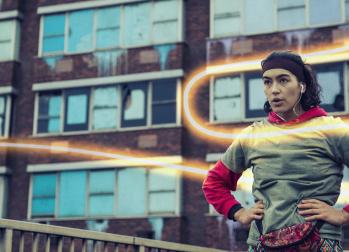The System Operability Framework (SOF) takes a holistic view of the changing energy landscape to assess the future operation of Britain's electricity networks.
The SOF combines insight from the Future Energy Scenarios with a programme of technical assessments to identify medium-term and long-term requirements for operability.
Evolving year-on-year
Through extensive industry interaction, the SOF evolves year‑on‑year to meet changing operational and stakeholder needs.
Growth of low carbon and renewable generation, closures of conventional thermal power stations and changing interactions across the whole of the power system are just a few of the areas considered in the context of a rapidly changing power system.
Operability Strategy Report 2024
The Operability Strategy Report explains the operability challenges we expect to face as the electricity system and industry continues to decarbonise. The report outlines our strategy for meeting these challenges as we progress to operating the electricity system at zero carbon for short periods of time in 2025, moving towards a zero carbon electricity system all of the time by 2035, in line with UK Government targets.
Download the report Download the webinar slides Download Q&A
Stability deep dive webinar - 28 March 2023
Following the Operability Strategy Webinar held on 24 January, we asked if you would like a 'deep dive' on a particular topic. Stability was the most popular and we ran an additional webinar on 28 March covering more detail on our stability requirements, how we measure system strength, and how we are evolving the procurement of stability services.
Power Quality in the GB Transmission Network
Power quality is critical to the performance of the plant and equipment connected to the power network. Poor power quality can reduce the efficiency, cause excessive heating or even damage the assets. Driven by the net zero targets, the penetration of Inverter-Based Resources (IBR) will continue to increase, which will reduce the system strength in certain areas of the network.
There is a direct correlation between system strength, traditionally measured by the Short Circuit Levels (SCL), and some of the power quality aspects, including harmonics, voltage unbalance and voltage flicker. This report discusses the main power quality aspects in the future GB transmission network.
Provision of short circuit level data
This paper explores options for how to define and reference short circuit level (SCL) for new and existing connections to the GB electricity system. This is required as more non-synchronous generation connects to the electricity system, alongside a reduction in traditional synchronous generators, impacting system stability. We describe why short circuit level is important and explore several options as to how short circuit requirements could be defined for new and existing generation. We are also seeking feedback from industry as to which of these options provides the optimum solution for defining short circuit level.
Download paper Feedback questions
Removing barriers to flexibility on the grid: interconnection
By 2025 interconnectors will become a key source of flexibility and will constitute a significant portion of the overall generation mix. Accessing flexibility and ancillary services on interconnectors will become key for system operability and an important pillar in our ambition for competition everywhere. So, following the publication of the BEIS Smart Systems and Flexibility plan, we’ve been looking into the barriers to interconnector participation in the Dynamic Containment market. Our report outlines those barriers and what mitigating actions could be taken.
National Trends and Insights
The UK’s transition to a low carbon economy is bringing many new challenges and opportunities to how National Grid ESO operates the GB electricity system, with flexibility becoming an increasingly valuable characteristic. As the Electricity System Operator, we are continuously working with industry stakeholders to transform our operations and delivering the right market solutions at the right time to benefit the end consumer. This document takes the output of National Grid’s ETYS and NOA processes in 2020 and looks further into the technical issues which may need to be addressed for the successful operation of a low carbon electricity system.
Low Demand - Operability Challenges from COVID-19 (Spring and Summer 2020)
The COVID-19 pandemic led to partial or total lockdowns in Great Britain in the spring of 2020, which in turn caused a reduction in electricity demand. This low demand, combined with large renewable output at times, resulted in a high penetration of non-synchronous machines on the system. This combination led to challenges with demand forecasting and maintaining flexibility for system integrity, voltage profiles and system stability. This paper provides a brief on the challenges in 2020 which National Grid ESO faced, the measures applied to tackle the challenges and the work we will look to carry out to improve the system operability in the future.
The potential operability benefits of Virtual Synchronous Machines and related technologies
We at National Grid ESO are always looking at ways to enable new technologies to connect to the network in the most safe, secure and efficient manner. This report discusses how new technologies can support system stability by adopting Virtual Synchronous Machine (VSM) technologies and associated control approaches which will enable transition to a zero carbon system.
More reports
Operability Impact of Distributed Storage and Electric Vehicles
The high penetration of these devices would alter demand. With appropriate market and framework design, storage and electric vehicles will be able to support electricity system operation and be enablers to the decarbonization transition.
Operating a Low Inertia System
We are always looking at how to best operate the network as we see reductions in system inertia. This report address the future challenges we see ahead of us as we transition to a zero carbon system.
This report provides the brief summary of significant frequency events which have previously been provided in the System Incident report to the Grid Code Review Panel.
Impact of declining short circuit levels
We are identifying and quantifying system requirements which are affected by reductions in Short Circuit Level and we share some of our work in this document.
Whole system short circuit level
Short circuit levels on the distribution networks are increasing driven by the growth in distributed generation and demand. This report looks at how these two trends interact and their net effect on the whole system.
Changes in the generation and demand are effecting how the power system is operated on a regional basis. Find out about our latest analysis by downloading the report.
Voltage and Frequency Dependency
Traditionally, voltage and frequency have been treated independently when considering operability. In the future, they will interact more. Find out about our latest analysis by downloading the report.
Past SOF documents
Operability Strategy Report
| Name | Published Sort ascending |
|---|---|
| Operability Strategy Report 2024 | 21 Dec 2022 |
| Operability strategy report 2023 | 21 Dec 2022 |
| Operability Strategy Report 2022 | 21 Dec 2021 |
| Operability Strategy Report 2021 | 8 Jan 2021 |
| Operability Strategy Report 2020 | 31 Dec 2019 |
| Operability Strategy Report 2019 update | 26 Jun 2019 |
| Operability Strategy Report 2018 | 30 Nov 2018 |
SOF 2016
| Name | Published Sort ascending |
|---|---|
| SOF 2016 - Data Tables | 3 Jan 2017 |
| SOF 2016 - Full Interactive Document | 30 Nov 2016 |
| SOF 2016 - Full Non-interactive Document | 30 Nov 2016 |
| SOF 2016 - September Post-assessment Webinar | 27 Sep 2016 |
| SOF 2016 - Launch Event Slides - Key Messages and Insights | 12 Sep 2016 |
| SOF 2016 - July Mid-assessment Webinar | 27 Jul 2016 |
| SOF 2016 - May Pre-assessment Webinar | 6 Jul 2016 |
SOF 2015
| Name | Published Sort ascending |
|---|---|
| SOF 2015 - Full Document | 30 Nov 2015 |
| SOF 2015 - Summary | 30 Nov 2015 |
| SOF 2015 - Launch Event Slides | 12 Jan 2015 |
SOF 2014
| Name | Published Sort ascending |
|---|---|
| SOF 2014 - Full Document | 9 Oct 2014 |
Subscribe to our mailing list and we'll let you know as soon as we publish any of our future of energy documents.
Contact us if you have a question, want to share some insight or have feedback.












